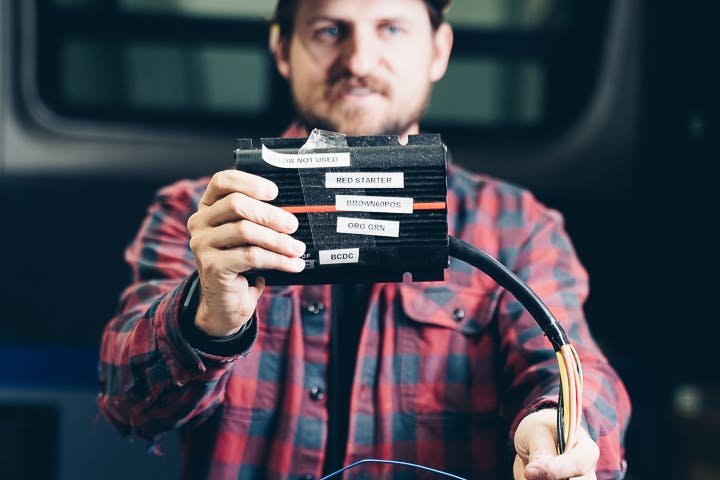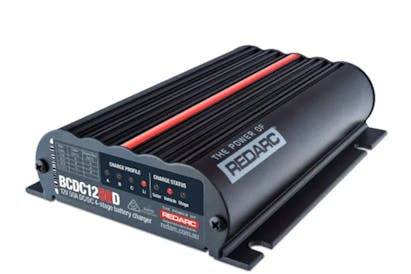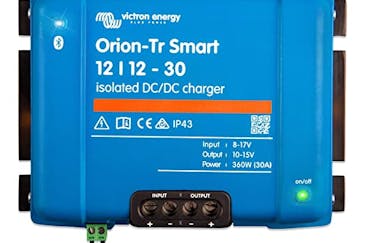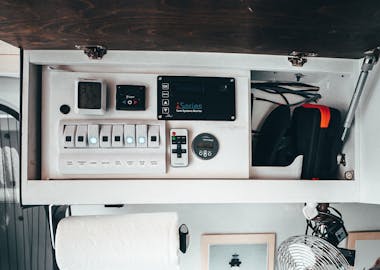
Sign up for The Wanderful newletter
Join our growing community of people looking to live the simple life!
Let’s build your van now
Join our growing community of people looking to live the Simple Life


)
When you’re living the vanlife, it’s easy to become hyper-focused on your battery and power levels.
“Is everything charging properly? Am I getting enough solar power? Can I use my blender this morning?”
Not having enough juice to power all your devices and appliances is a daily worry for many vanlifers. After all, electricity is the last thing you want to worry about when enjoying the countryside or attempting to live “off-grid”.
In this article, I’m going to share a very important ‘vanlife electrical’ tip to take some of that stress away – How to charge your house batteries with your alternator. I’ll highlight:
Your van comes with a built-in power generator; the alternator. The alternator’s job is to keep your starting battery charged so that it can power all of your van’s electrical needs (the radio, air conditioner, lights, and so on).
Now you’ve converted your van into a camper.
Since your starting battery is not powerful enough to power all of your new household needs (your fridge, lights, fans, computers, etc), you’ll need to install house batteries (also known as secondary or auxiliary batteries) and charge those using an alternate source.
Most commonly, vanlifers use solar power to charge their house batteries (the second battery responsible for supplying power to these appliances). The most obvious drawback is that you don’t get any power when there is no sun.
Another popular way is to charge your house battery with the alternator simply by driving around!

Whether you can charge your house battery from your alternator depends on how big your alternator is. Typically, only 50 percent or half of your total amperes will be available to charge your house battery.
This means that if you have a 220 amperes alternator in your van, you will have a maximum of 110 amperes available for your house battery charging.
The reason for using the rule of 50% is because running your alternator at full output all the time will cause your alternator to shorten its lifespan and fail quicker
As alternators are quite expensive, you don’t want to wear them down.
FOR AGM Auxillary Batteries
The blue sea SI-ACR Charging Relay is a good option if you are looking for a robust relay to isolate battery charge for AGM house batteries.
A few benefits include:
The main benefit of using something like the Blue Sea Si-ACR is that when you start your vehicle, it will charge the vehicle battery first, once it recognizes that the vehicle battery is fully charged, it will then start charging the house batteries. This way, your start battery is always full. The second function is that when your vehicle is shut off, the SI ACR will disconnect from the house batteries so you can not drain the start battery while powering the appliances in the living area of the van.

A DC-DC charger, also known as a battery-to-battery charger, uses your main battery to charge your house battery (or batteries) quickly and efficiently. It uses a process known as bulk-absorption-float to maximize the charge in your house battery and ensure that it’s charged to the maximum.
This charging method is primarily used when charging Lithium house batteries using the alternator. Since lithium batteries are different chemistry than the vehicle start battery, the DCDC charger is able to properly charge the different battery types to avoid damage and provide proper charging profiles.
It can do this by increasing the power and efficiently charging your van. You can easily get a 100% charge in your secondary battery with a full day of driving.
If you are still confused about what a DC-DC charger is and how it helps you to charge your van’s electrical system, here’s a detailed article that you may find useful: What is a DC-DC Battery Charger?
Several brands make DC-DC chargers, including RedArc, Victron, and Renogy. All these brands have different pros and cons, which make them suitable for different users. Here’s how their feature and benefits line up
RedArc

Victron

Renogy
Sterling

We recommend RedArc because:
Isolators are also used to charge the secondary battery through the alternator by isolating the main battery from the secondary battery. Both the main battery and auxiliary batteries are connected, and the isolator is connected to the alternator.
You can think of an isolator as a gateway that lets voltage pass only in one direction, so if the alternator is charging the main battery at 12V, it will also push the same power to the secondary battery. This means the secondary battery won’t drain your main battery by consuming its amperage to run the van’s electrical system.
A battery isolator is more like an on and off switch
Recommendation
While there are many affordable battery isolators, we recommend the RedArc SPI 12. This solenoid battery isolator uses 12V with 100 amperes of ratings. It’s easy to install and compact in size. The RedArc SPI 12 also uses power-saving technology and fault indication for enhanced utilization.
The short answer is yes! You can use a DC-DC charger and a battery isolator together. The first thing to notice here is that typically the main battery of the campervan is a lead acid battery such as AGM, while house batteries tend to be lithium because of their efficiency and long life.
Therefore, the battery isolator will always ensure there is enough charge for your cranking battery to start your engine. It will not regulate the amperage flowing to your auxiliary battery, therefore over/undercharging it.
To get around this problem, you will need a DC-DC battery charger that can manage the current flowing into the secondary battery. That’s why you can use a DC-DC charger in conjunction with your battery isolator to enhance your van’s electrical system and make it foolproof.
Charging your van’s electrical system with the alternator has several key benefits.
These are listed below:
You will feel better equipped with charging your van’s electrical system through an alternator as it’s a relatively easy and more reliable option for charging your house batteries.
Here are a few key takeaways from this article:
)
Converting a van yourself can help save you money, but not all components are worth the time and headache to make yourself. Here are 5 things that I would most certainly not make myself if I could go back in time.
)
Once you’re ready to start planning out your vans power and electrical system, one of the decisions you will need to make is which type of battery to use.
)
It’s natural to become hyper-aware of all the systems you have on the go in your new home-on-wheels.